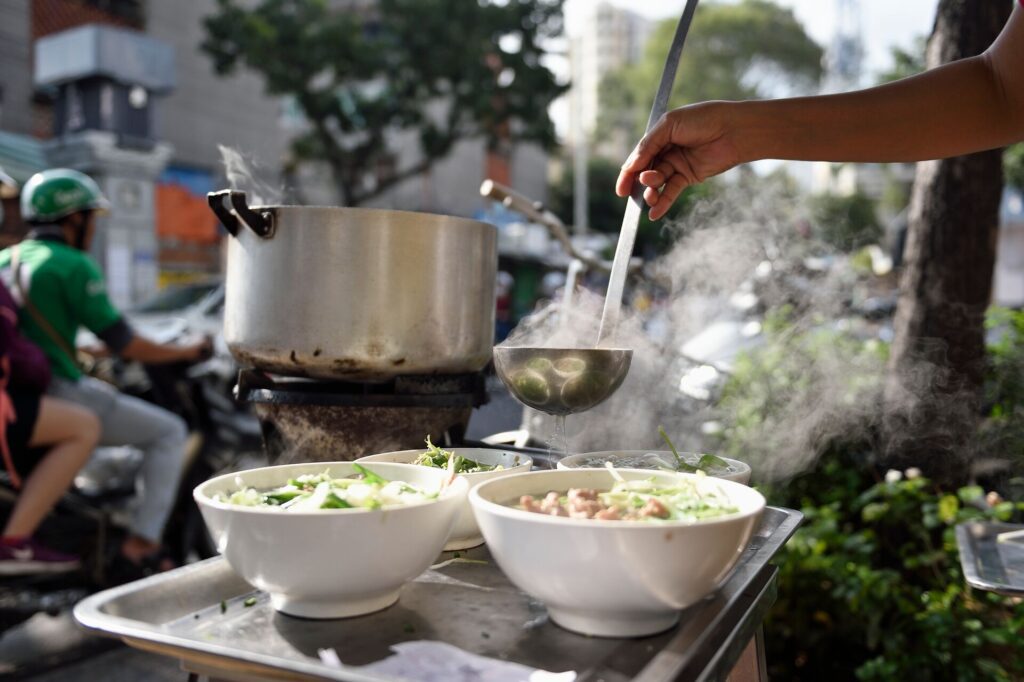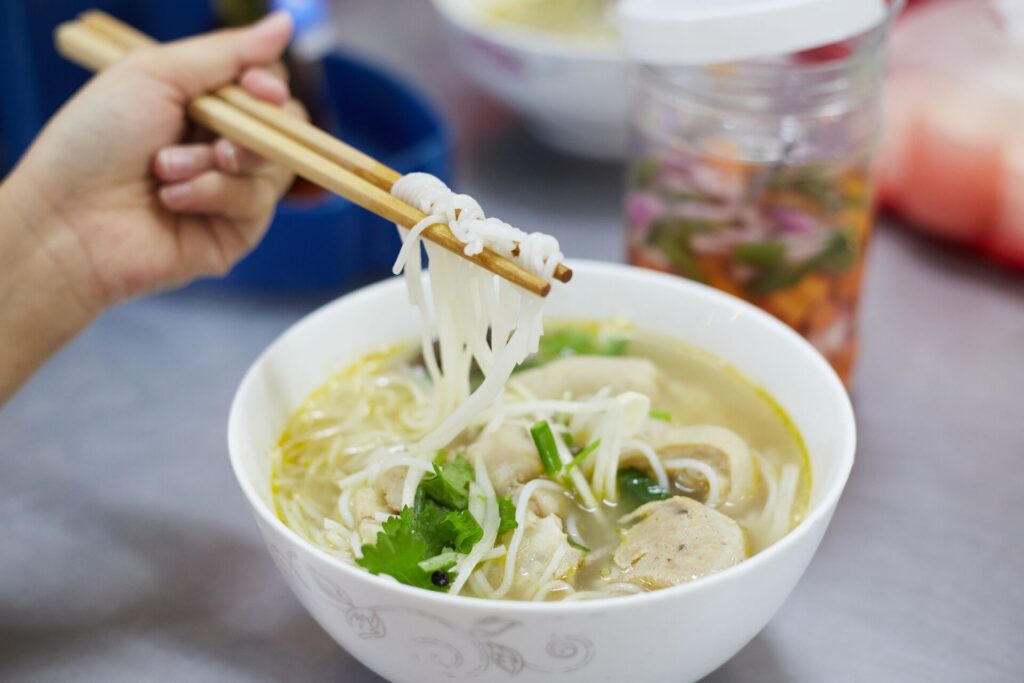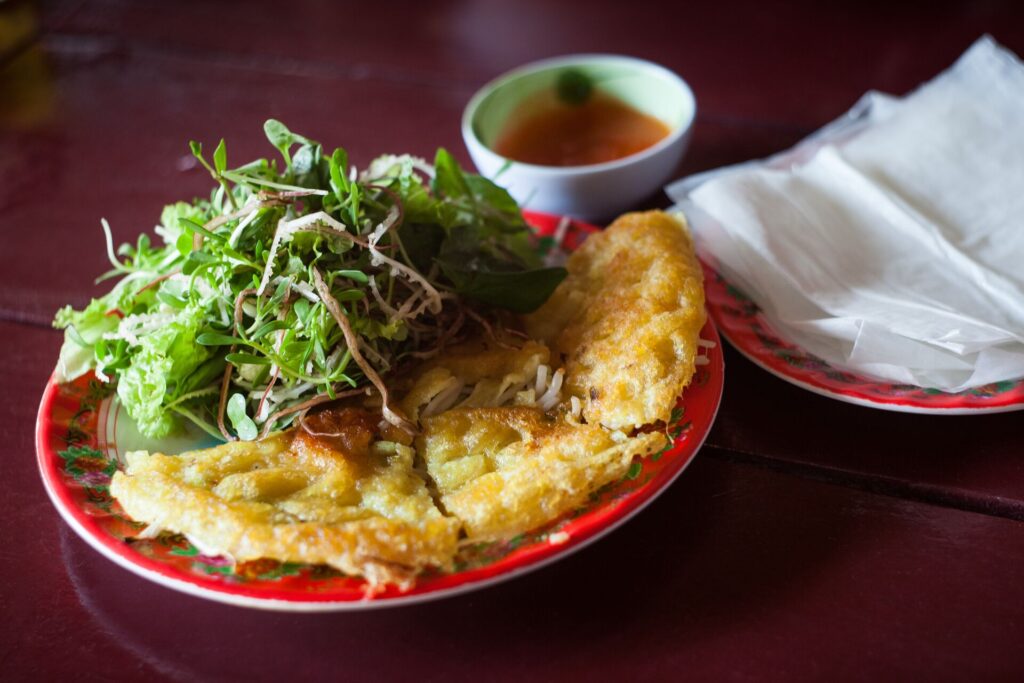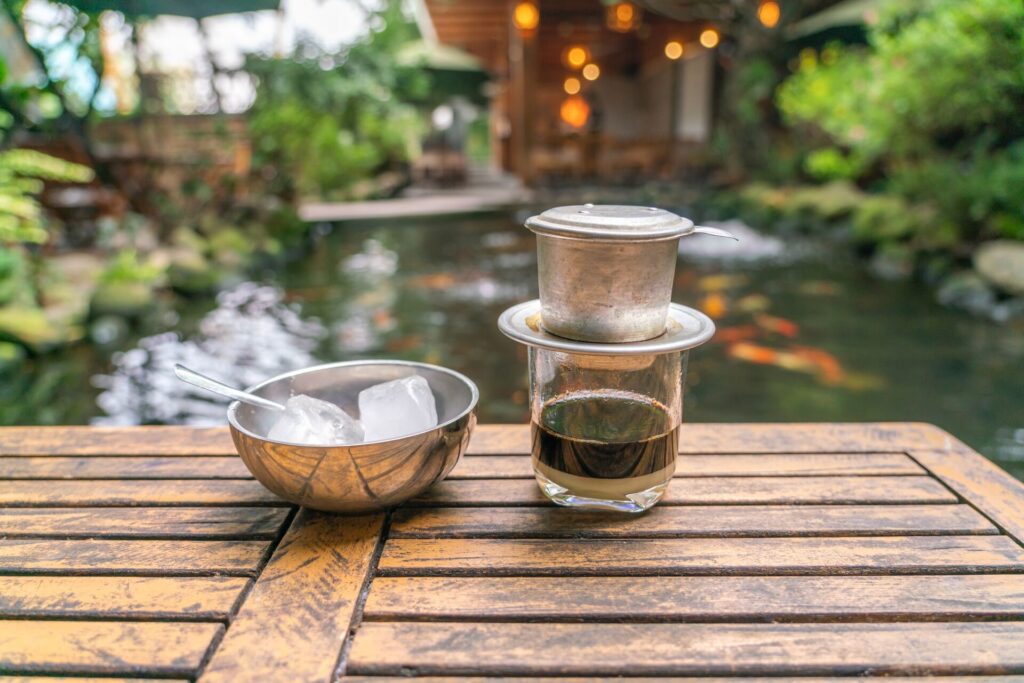Recently updated on May 8th, 2025 at 04:45 am
The Flavours of Vietnam
A journey through Vietnam serves memorable dining on a platter. Lauded for its vibrant flavours, colourful presentations, unique textures, fresh ingredients and delicate balance of sweet, sour, salty, and bitter elements, Vietnamese cuisine showcases the country’s rich cultural heritage. Each dish tells the story of its regional influences: around Hanoi in the north, flavours tend to be milder but still complex, with dishes like phở (noodle soup) and bún thang (a light chicken soup) representing the city’s culinary focus on subtle flavours over spice. Central Vietnam, home to cities like Hoi An, Hue and Da Nang, is celebrated for its bold, spicy flavours and aromatic broths, where meals like cơm hến (clam rice) and bún bò Huế (spicy beef noodle soup) are highlights. Meanwhile, in the south, particularly in Ho Chi Minh City, dishes often feature a subtle sweetness, with hu tieu (noodle soup with pork and seafood) and bánh xeo (savoury crispy pancakes) being local favourites. So, wherever your tastebuds lead you across north, south or central Vietnam, your hunger will always be more than satisfied in this vibrant Southeast Asia’s ultimate foodie playground. Here, just a few of the must-try dishes and where to dig into them…


Northern Vietnamese Dishes
The flavours of Hanoi, Ha Long, Sapa, Ninh Binh, Mai Chau and Ha Giang emphasise subtle, clean flavours and light, aromatic broths. Unlike the spicier dishes found elsewhere, northern flavours focus on balance, highlighting fresh vegetables, herbs, meats and seafood. Signature dishes use less sugar and fewer chillies than in other regions, relying on fish sauce and herbs like coriander, mint and basil for depth and contrasts instead. Order these standouts:
- Phở: A noodle soup made from a clear, aromatic bone broth, rice noodles, slow-cooked beef or chicken, and garnished with fresh herbs, Vietnam’s national dish can be enjoyed everywhere from top restaurants to home-style street-food stalls. Compared to the south’s version, northern phở has slightly thinner, more delicate noodles, minimal sweetness and subtle flavours enhanced by small amounts of fresh herbs.
- Bún thang: Originating in Hanoi, this light noodle soup with round rice vermicelli noodles and chicken broth is usually topped with shredded chicken, flavoured with fish sauce, eggs, and herbs, and eaten for breakfast.
- Chả Cá La Vong: Hanoi-style grilled catfish seasoned with dill and turmeric, served with vermicelli noodles and fried at your table. The dish originated during the early French colonial days when the Doan family opened their home as a meeting place for patriots, supporting their efforts by serving them the fish they caught and cooked.
- Bún chả: Hanoi’s iconic dish of grilled fatty pork with vermicelli noodles and dipping sauce became even more popular when Barack Obama and Anthony Bourdain enjoyed it during a meal together in Hanoi.
- Xôi: Steamed sticky rice that comes in a variety of sweet and savoury options, from xôi sau rieng (sticky rice with durian) to xôi thit kho (sticky rice with braised pork belly) – and everything delicious in between.
- Bánh cuốn: Steamed rice-paper rolls filled with pork, mushroom, shallots that’s often eaten as breakfast or a snack.
Standout Northern Vietnam Dining Experiences:
Take a seat at the table in KOTO – this excellent Hanoi eatery is a not-for-profit social enterprise offering hospitality training to disadvantaged youth as well as authentic local fare (visit KOTO as part of our Authentic North Vietnam adventure). For a contemporary take on classic phở, bún chả and other northern must-tries, head to the opera-themed Backstage or Hanoi Garden and, for more traditional flavours, don’t miss Phở Gia Truyền, Chả Cá Anh Vu or Bún Chả Chan.


Central Vietnamese Delicacies
Spanning Hoi An, Hue, Da Nang, Nha Trang, Phong Nha and Da Lat, Central Vietnam is known for its spicy, intense flavours, often featuring chilli, bone broth, garlic, fermented shrimp paste and lemongrass to create a complexity of savoury, spicy, herbal and umami elements. Colourful presentations are often as important as the balance of flavours, especially in the imperial dishes of Hue, while street food is known for its appetiser-sized portions and bold flavours. Some of the Central region’s most iconic dishes include:
- Bún bò Huế: A spicy beef noodle soup hailing from Hue and featuring a rich broth made by simmering beef and pork bones, lemongrass, shrimp paste, and chilli. It’s served with thick round rice noodles and a mix of beef (like brisket, oxtail or tendon) and pork (including blood cubes or knuckles), then topped with herbs, lime, and chili.
- Cơm hến: This rustic fried rice dish is topped with small river clams sautéed with garlic, lemongrass, and chilli to create a savoury, slightly spicy mix. It’s served with crunchy toppings like fried shallots, peanuts, and herbs, as well a rich clam-stock broth.
- Bánh bèo: These bite-sized steamed rice cakes are topped with dried shrimp, crushed peanuts, fried shallots and a drizzle of fish sauce; often accompanied by broth or dipping sauce, and enjoyed as an appetiser or a portable street-food snack.
- Cao lầu: This historic noodle dish has Chinese and Japanese influences as it originated in the 17th Century when Hoi An was an important trading port. Its rice noodles are made with lychee wood ash and water from the Ba Le well, which is said to give the dish its distinctive texture and flavour, and it’s served with sliced pork, herbs, crunchy croutons, and a savoury broth.
- Mì quảng: Part salad, part noodle soup, totally delicious. This Da Nang dish features flat rice noodles served in a small amount of pork, chicken or shrimp broth and enhanced with turmeric. Unlike typical noodle soups, it’s topped with fresh salad vegies, herbs, bean sprouts, crushed peanuts, fried shallots and lime
- Gỏi cuốn: These fresh spring rolls are light, healthy and very popular. Made with soft translucent rice paper, they’re filled with a combination of prawns, pork (or occasionally beef or tofu), fresh herbs, crisp lettuce, vermicelli noodles, and crunchy bean sprouts, and served with peanut or hoisin dipping sauce.
Standout Central Vietnam Dining Experiences:
Visit the Tra Que Herb Garden to meet the farmers and learn to cook some of Hoi An’s tastiest dishes with vegies and herbs straight from the garden – this memorable Make Travel Matter Experience is part of our 13-day Authentic Vietnam adventure. Also, when you visit Hue on our Authentic Indochina journey, you’re invited to dinner with the Doan family, who’ll share their cooking techniques and a delicious Central Vietnamese feast with you. Keen to restaurant-hop? In Hoi An, try cao lầu at Hoi An Heart Restaurant and traditional fare at Home Hoi An. Bánh Gánh Restaurant and Nhà Hàng Khải Hoàn are highlights in Hue, while Quán Nhân and Thìa Gỗ spotlight Da Nang’s authentic flavours.


Southern Vietnamese Specialties
Southern Vietnam encompasses Ho Chi Minh City (formerly Saigon), Con Dao, Binh Thuan, Can Tho, Chau Doc and Phu Quoc, and its cuisine is known for its sweetness, freshness, and plentiful herbs and tropical ingredients. While northern flavours are subtle and savoury, and central fare favours the rich and spicy, southern food is all about the sweet-salty contrasts, with seafood, coconut milk, sugar, mango, pineapple, papaya, coriander, mint and basil included to create vibrant, complex flavours. Sink your teeth into these local classics:
- Bánh xèo: Vietnam’s iconic crispy savoury pancakes are made from rice flour, turmeric and coconut milk; filled with prawns, pork, bean sprouts and onions, and served with fresh herbs, lettuce leaves, and a tangy dipping sauce. The dish is especially popular in the Mekong Delta, where the abundance of fresh vegies and seafood ensure it is extra flavourful.
- Phở Nam: Compared to northern phở, the south’s take on the classic has a richer, sweeter broth, thicker noodles, and more lavish toppings with plentiful fresh herbs, bean sprouts, lime, hoisin sauce and sriracha.
- Cơm tấm: This southern staple has humble origins as it was traditionally eaten by the working class (its name translates to ‘broken rice,’ referring to the inexpensive grains often discarded by rice mills). It features pork marinated in a rich, sweet, savoury sauce, is served with pickled carrots and daikon, and garnished with fried shallots, fresh herbs, chilli and fish sauce.
- Bánh mì: These Vietnamese sandwiches are a beloved fast food often eaten for breakfast or lunch. They consist of a crispy bread roll or baguette – a legacy of French colonial influence – stuffed with a mix of fresh ingredients like grilled pork, chicken, pâté, pickled vegetables, coriander and
- Bò kho: A hearty stew of beef, lemongrass, star anise, ginger, and other spices often eaten for breakfast or as a comfort food.
- Hủ tiếu Nam vang: This noodle soup is a popular street-food option for breakfast or lunch, originating in Phnom Penh, Cambodia, but becoming locally adapted with Vietnamese ingredients. The dish features rice noodles in a clear, savoury broth made by simmering pork bones, prawn shells, and fish sauce, and it’s served with a mix of pork, prawns, fish balls, and sometimes beef. Garlic, fried shallots, and fresh herbs are common toppings.
- Bún thịt nướng: A light, refreshing noodle salad combining grilled with rice vermicelli noodles. The pork is usually marinated in a savoury-sweet mix of fish sauce, sugar, garlic, and lemongrass, then chargrilled for a smoky flavour, while the noodles are topped with crisp lettuce, bean sprouts, fresh herbs, crushed peanuts and fried shallots.
- Bò lá lốt: This flavourful favourite consists of finely minced beef, often mixed with garlic, lemongrass, onions, and spices, then wrapped in betel leaves and grilled over charcoal.
Standout Southern Vietnam Dining Experiences:
Adventure World’s 10-day Flavours of Vietnam itinerary is packed with authentic foodie experiences including a Saigon street-eats discovery tour, a memorable lunch at Mrs Mai’s restaurant in the Mekong Delta, and more. When dining out in Ho Chi Minh city, keep an eye out for local favourites like Anan Saigon, Bò Kho Gánh, Hoa Túc, Cloud Nine Saigon, and Bánh Mì Huynh Hoa.


More Vietnamese Regional Dishes, Snacks and Desserts to Try
While the above outlines Vietnam’s key dishes, it’s by no means exhaustive and part of the joy of exploring this diverse, vibrant country is discovering your own favourites. Be sure to give these highlights a taste-test if your travels lead you to them:
- Nộm hoa chuối: This refreshing side dish or appetiser is made from shredded banana blossoms combined with herbs, vegetables, and a tangy, savoury dressing.
- Bot chien: These fried rice flour cakes are particularly popular as a late-night treat in southern Vietnam. Made from rice flour, these bite-sized cakes are fried until they’re crispy on the outside but soft on the inside, and served with fried eggs, green onions and a salty-sweet dipping sauce.
- Cá kho tộ: Catfish braised in a clay pot with a rich, savoury-sweet sauce made from a mixture of fish sauce, sugar, garlic, shallots, black pepper, and sometimes caramelised sugar. The slow cooking process allows the fish to absorb all the rich seasonings, and it’s often served with a side of rice, making for a comforting hearty dish that’s a staple in Southern Vietnamese homes.
- Chè ba màu: A popular street-eat found across the country, Vietnam’s three-colour dessert consists of three-layers. The bottom layer is usually a smooth, slightly sweet mung bean paste; the middle is red or kidney beans for an earthy contrast, while the top is made from pandan jelly or green mung bean, creating a fragrant, slightly chewy texture. It’s usually served with crushed ice and coconut milk.
- Bánh bao vac: These signature Hoi An bites are also known as white rose dumplings, made from translucent rice dough shaped into pleated segments resembling rose petals. They’re usually filled with seasoned prawns or pork, flavoured with garlic, onion, and spices, steamed, and served with a dipping sauce.
- Bánh căn: This street-food snack consists of savoury rice pancakes cooked over a charcoal, filled with prawns, pork, or quail eggs; garnished with herbs and fried shallots, and served with a rich dipping sauce.


3 Vietnamese foodie FAQs, answered
What is the most famous Vietnamese dish?
Phở, for sure – and you’ll find it everywhere from lauded restaurants to home-style hawkers across the country, with flavours varying from region to region. This iconic noodle soup is the country’s national dish, made with noodles, bone broth, herbs, spices and meat (usually beef or chicken), with each element carefully balanced.
What’s the difference between phở and bún bò Huế?
Phở has a clear, delicate, balanced broth made from simmered beef bones, fish sauce, herbs, and spices. The rice noodles used in phở are thin and flat, and it’s usually served with beef (or sometimes chicken) and garnished with fresh herbs, bean sprouts, lime, and chilli. On the other hand, bún bò Huế is known for its spicy broth, which is made from beef and pork bones, pork blood cubes, shrimp paste, lemongrass and chilli, so it has a rich, fiery flavour. The noodles in bún bò Huế are round and thicker than those in phở and they’re served with a mix of beef and pork.
Where can I try the best phở in Vietnam?
That depends on your preferences because Vietnam’s signature noodle soup has regional variations. In Hanoi, the birthplace of phở, you’ll find the most traditional version, with a clear, light broth, thin rice noodles and simple but savoury flavours. In Ho Chi Minh City, the southern style of phở is richer and sweeter, with a more intense broth, thicker noodles, and plenty of fresh herbs, hoisin sauce and sriracha. Meanwhile Hue’s unique version has a slightly fiery kick thanks to local spices.
